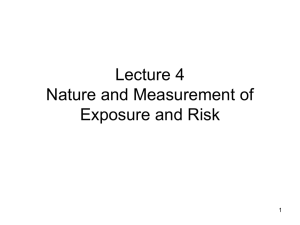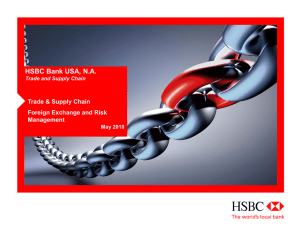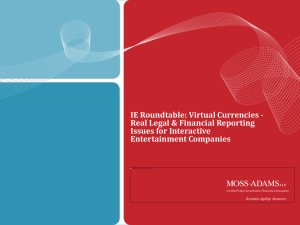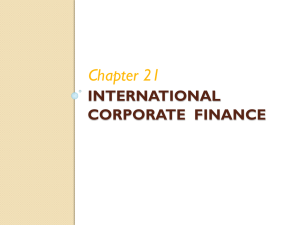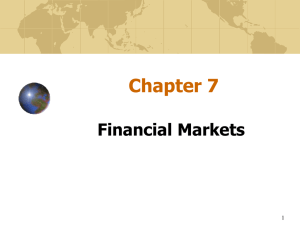8am - Mitigating Foreign Currency Risk - Heather Boyer
advertisement
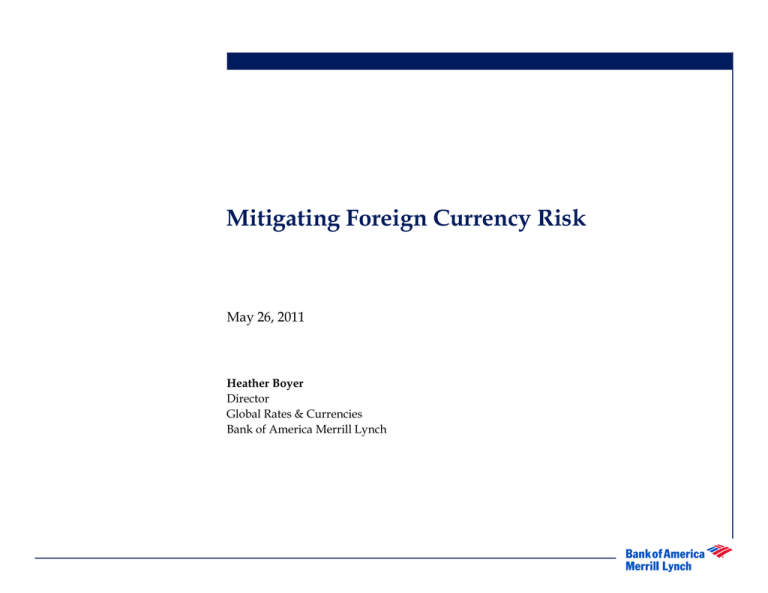
Mitigating Foreign Currency Risk May 26, 2011 Heather Boyer Director Global Rates & Currencies Bank of America Merrill Lynch Table of Contents Table of Contents • Overview of Global Foreign Exchange Markets • Identifying Currency Risk • Assessing and Addressing and Currency Risk 2 Global Foreign Exchange Market Global Foreign Exchange Market ■ Globalization of economic activity and the gradual adoption of floating exchange rates makes it virtually impossible for firms to avoid exposure to foreign currency risk. ■ Global firms engage in a broad range of activities that can expose their economic and financial performance to variation from fluctuating exchange rates: Foreign sales Foreign-sourced inputs Overseas operations and/or investments Foreign financing. Indirect effects, due to foreign competition ■ Each of these activities represents a potential channel through with currency fluctuations might affect firm performance. 4 Global Foreign Exchange Market ■ Fueled by corporate and investor needs, the global FX market is the world’s largest financial market. ■ Average daily turnover, including traditional FX products (spot, forwards, and swaps) and OTC options, estimated at $4.0 trillion (BIS, April 2010). Up roughly 20% compared to 2007 (BIS, April 2010). Trading activity by “other financial institutions” including non-regulated banks, hedge funds, pension funds, and central banks among others increased 42% in 2010 (BIS, April 2010). ■ Vast majority of transactions in OTC market. ■ A broad mix of market participants – central banks, financial institutions, investors, multinational corporations. 5 Global Foreign Exchange Market ■ The market operates “24-hours” a day. ■ Foreign Exchange Turnover as a percentage of global turnover (BIS, April 2010). Country 1998 2001 2004 2007 2010 Australia 2.3 3.2 4.1 4.1 3.8 Canada 1.8 2.6 2.3 1.5 1.5 France 3.7 2.9 2.6 3.0 3.0 Germany 4.7 5.4 4.6 2.4 2.1 Hong Kong 3.8 4.0 4.1 4.2 4.7 Japan 7.0 9.0 8.0 5.8 6.2 Switzerland 4.4 4.5 3.3 5.9 5.2 United Kingdom 32.6 32.0 32.0 34.6 36.7 United States 18.3 16.1 19.1 17.4 17.9 6 Global Foreign Exchange Market ■ The intensification of international commerce has been accompanied by a rise in currency volatility, due principally to: Increase in cross border financial flow fuel by deregulations of domestic financial markets and the liberation of restricted capital flows. Greater flexibility in once managed or fixed exchange rate regimes. The tendency of economic authorities to reduce their reliance on fixed/tightly managed currency policies and to allow flexibility in exchange rates. Dramatic shifts in fiscal policy in response to the financial crisis of 2008. 7 Global Foreign Exchange Market 8 Global Foreign Exchange Market ■ Currency Volatility is influenced by short and long term factors. ■ Short term Supply and demand Cross border flow Market Positioning ■ Long term Trade imbalances Fiscal policy Growth ratios 9 Identifying Currency Risk Identifying Currency Risk ■ Global operations engage in a broad range of activities that can exposure their economic and financial performance to currency fluctuations. ■ Identifying the currency exposure is a key component of mitigating that risk. 11 Identifying Currency Risk ■ Direct sources of currency risk are typically assets or liabilities denominated in a currency other than the entity’s functional currency. ■ Accounting groups describe these exposures as transaction, translation or economic exposures. Foreign sales Foreign sourced inputs Foreign operations or international investments Foreign financing Foreign competition indirectly influencing sales. – Selling in a foreign market when the dollar is weak may artificially inflate sales. – Selling in a foreign market when the dollar is strong my erode sales due to local competition 12 Identifying Currency Risk ■ Watch for hidden exposures. Contracts nominal currency price , does not match the currency that determines the real price. – Commodity contracts priced in a foreign currency but the commodity is traded in US dollars. Contracts with a currency clause – The exchange rate is a function of the final price. – Shared agreements do not always effectively mitigate this risk. Fabricating a “Natural Hedge”. ■ Account for non-currency exposures. What is the notional of the foreign exposure? Can it change and why? What is the timing of the cash flow? Is it subject to change? 13 Assessing and Addressing Currency Risk Assessing Currency Risk ■ Quantify the currency risk. Fixed currency – What is the probability of a revaluation? – What are the local currency restrictions? Floating currency – What is the implied volatility? – Historically, what have been highs and lows? ■ Is the exposure material? Margins versus volatility: is the volatility meaningful to profitability? What percentage of the overall business is exposed to currency risk? 15 Assessing Currency Exposure ■ Utilize internal risk reduction opportunities. Identify naturally occurring offsets to FX exposures sometimes called a “natural hedge”. – Local foreign currency debt – Local foreign currency proceeds ■ Consider exposure correlations with other asset classes such as commodities. 16 Design a Plan ■ Establish clear risk management objectives. Maintain margins (budget levels) Eliminate FX gains/Losses Minimize Hedging Cost Optimize the Value of Cash ■ Employ a structured hedging strategy with a written policy. Structure discipline around the hedging process. – Do not allow market views to drive hedging decisions. Create transparency with in the organization. – Aid in selection of products that fit firm’s risk management goals. Decrease continuity risk in the event of staffing changes. Include a review period for policy. 17 Understand Risk Management Tools ■ Choose strategies that comply with risk management goals and exposures. ■ Weigh all consideration when selecting a product. Certainty of forecast View of Currency Budget Rate Cost Concern Flexibility Settlement Risk Considerations Certainty of forecasts View of Currency Valuation Budget Rate Concern Cost Concern Flexibility Settlement Risk Options Forecast uncertain Potential to participate in favorable move If market has moved away from budget, option-based strategy gives hedger a chance to hit budget rate Consider zero-premium strategies or deferred premium alternatives Hihg- hedge can be restructred to suit changes in exposure or market No negative cash impact at expiry 18 Forwards Forecast certain Transaction rates are locked-in If market has moved away from budget, hedger will be locked into hedged rate without ability to meet budget rate Interest rate differential in favor or against hedger No flexibility Potential cash payout to bank if underlying moves favorably Monitoring Performance ■ Effective risk management requires monitoring of the exposure and the hedges. To ensure prudent control over risk management process To monitor whether the hedging strategy is achieving the risk management goal. To comply with relevant accounting and regulatory requirements. ■ Periodic review and revise the policy and strategy. 19 Disclaimer Disclaimer “Bank of America Merrill Lynch” is the marketing name for the global banking and global markets businesses of Bank of America Corporation. Lending, derivatives, and other commercial banking activities are performed globally by banking affiliates of Bank of America Corporation, including Bank of America, N.A., member FDIC. Securities, strategic advisory, and other investment banking activities are performed globally by investment banking affiliates of Bank of America Corporation (“Investment Banking Affiliates”), including, in the United States, Banc of America Securities LLC and Merrill Lynch, Pierce, Fenner & Smith Incorporated, which are both registered broker-dealers and members of FINRA and SIPC, and, in other jurisdictions, locally registered entities. Investment products offered by Investment Banking Affiliates: Are Not FDIC Insured * May Lose Value * Are Not Bank Guaranteed. These materials have been prepared by one or more subsidiaries of Bank of America Corporation for the client or potential client to whom such materials are directly addressed and delivered (the “Company”) in connection with an actual or potential mandate or engagement and may not be used or relied upon for any purpose other than as specifically contemplated by a written agreement with us. These materials are based on information provided by or on behalf of the Company and/or other potential transaction participants, from public sources or otherwise reviewed by us. We assume no responsibility for independent investigation or verification of such information (including, without limitation, data from third party suppliers) and have relied on such information being complete and accurate in all material respects. To the extent such information includes estimates and forecasts of future financial performance prepared by or reviewed with the managements of the Company and/or other potential transaction participants or obtained from public sources, we have assumed that such estimates and forecasts have been reasonably prepared on bases reflecting the best currently available estimates and judgments of such managements (or, with respect to estimates and forecasts obtained from public sources, represent reasonable estimates). No representation or warranty, express or implied, is made as to the accuracy or completeness of such information and nothing contained herein is, or shall be relied upon as, a representation, whether as to the past, the present or the future. These materials were designed for use by specific persons familiar with the business and affairs of the Company and are being furnished and should be considered only in connection with other information, oral or written, being provided by us in connection herewith. These materials are not intended to provide the sole basis for evaluating, and should not be considered a recommendation with respect to, any transaction or other matter. These materials do not constitute an offer or solicitation to sell or purchase any securities and are not a commitment by Bank of America Corporation or any of its affiliates to provide or arrange any financing for any transaction or to purchase any security in connection therewith. These materials are for discussion purposes only and are subject to our review and assessment from a legal, compliance, accounting policy and risk perspective, as appropriate, following our discussion with the Company. We assume no obligation to update or otherwise revise these materials. These materials have not been prepared with a view toward public disclosure under applicable securities laws or otherwise, are intended for the benefit and use of the Company, and may not be reproduced, disseminated, quoted or referred to, in whole or in part, without our prior written consent. These materials may not reflect information known to other professionals in other business areas of Bank of America Corporation and its affiliates. Bank of America Corporation and its affiliates (collectively, the “BAC Group”) comprise a full service securities firm and commercial bank engaged in securities, commodities and derivatives trading, foreign exchange and other brokerage activities, and principal investing as well as providing investment, corporate and private banking, asset and investment management, financing and strategic advisory services and other commercial services and products to a wide range of corporations, governments and individuals, domestically and offshore, from which conflicting interests or duties, or a perception thereof, may arise. In the ordinary course of these activities, parts of the BAC Group at any time may invest on a principal basis or manage funds that invest, make or hold long or short positions, finance positions or trade or otherwise effect transactions, for their own accounts or the accounts of customers, in debt, equity or other securities or financial instruments (including derivatives, bank loans or other obligations) of the Company, potential counterparties or any other company that may be involved in a transaction. Products and services that may be referenced in the accompanying materials may be provided through one or more affiliates of Bank of America Corporation. We have adopted policies and guidelines designed to preserve the independence of our research analysts. These policies prohibit employees from offering research coverage, a favorable research rating or a specific price target or offering to change a research rating or price target as consideration for or an inducement to obtain business or other compensation. We are required to obtain, verify and record certain information that identifies the Company, which information includes the name and address of the Company and other information that will allow us to identify the Company in accordance, as applicable, with the USA Patriot Act (Title III of Pub. L. 107-56 (signed into law October 26, 2001)) and such other laws, rules and regulations as applicable within and outside the United States. We do not provide legal, compliance, tax or accounting advice. Accordingly, any statements contained herein as to tax matters were neither written nor intended by us to be used and cannot be used by any taxpayer for the purpose of avoiding tax penalties that may be imposed on such taxpayer. If any person uses or refers to any such tax statement in promoting, marketing or recommending a partnership or other entity, investment plan or arrangement to any taxpayer, then the statement expressed herein is being delivered to support the promotion or marketing of the transaction or matter addressed and the recipient should seek advice based on its particular circumstances from an independent tax advisor. Notwithstanding anything that may appear herein or in other materials to the contrary, the Company shall be permitted to disclose the tax treatment and tax structure of a transaction (including any materials, opinions or analyses relating to such tax treatment or tax structure, but without disclosure of identifying information or, except to the extent relating to such tax structure or tax treatment, any nonpublic commercial or financial information) on and after the earliest to occur of the date of (i) public announcement of discussions relating to such transaction, (ii) public announcement of such transaction or (iii) execution of a definitive agreement (with or without conditions) to enter into such transaction; provided, however, that if such transaction is not consummated for any reason, the provisions of this sentence shall cease to apply. Copyright 2009 Bank of America Corporation. 20


